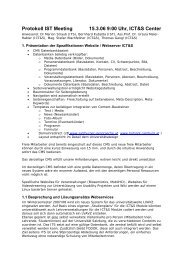CHRISTIAN FUCHS - ICT&S - Universität Salzburg
CHRISTIAN FUCHS - ICT&S - Universität Salzburg
CHRISTIAN FUCHS - ICT&S - Universität Salzburg
You also want an ePaper? Increase the reach of your titles
YUMPU automatically turns print PDFs into web optimized ePapers that Google loves.
Christian Fuchs: Social Networking Sites and the Surveillance Societythat therefore all people should always set their profiles to fully private. That there aresingle examples for such acts or that there is a certain amount of occurrences does notimply that all users are at high risk. People can also be and are also harassed, stalked,etc in non-virtual life. And although there is a certain threat of becoming a victim outon the street, most individuals will not consider never again leaving the house they livein. Just like not leaving your house is not an option, not using the Internet or not usingISNS is not a realistic option for most users. The victimization discourse is morallyconservative and as a tendency anti-fun. One needs to change society for findingsolutions to problems. There are no technological fixes to societal problems. Societalproblems, such as state surveillance after 9/11, corporate interests, or thecommodification of personal data in the form of spam and advertising, that frameInternet use are political problems, not individual ones.Jones, Millermaier, Goya-Martinez and Schuler (2008) conducted a content analysis ofMySpace sites (N=1378).“The overwhelming majority of profiles sampled (98.3 percent) were public andnearly two–thirds (61.5 percent) appeared to display a self–portrait as the user’sidentifying image. An additional 14.4 percent included an image of the user witha friend or romantic partner. (…) most were more conservative in their disclosureof more sensitive identifying information. On their profile pages, 78.4 percent ofusers in the sample displayed their first name while only 11.0 percent disclosedtheir full name. Approximately two–thirds of users sampled (64.5 percent)displayed their first name as their online user name specifically, while a mere 1.9percent of users used their full name as their user name. Less than one percent(0.80 percent) used a realistic name, although 3.60 percent of user names were acombination of a nickname with a real name. About 14.6 percent used an onlinehandle (an ID name used on Internet sites) as their user name, while 9.4 percentused a phrase (…) It is interesting to note that only 2.7 percent outright displayedtheir IM name given the apparent preference for this method of communication.An even smaller proportion of users, only one percent, included an e–mailaddress in their profile. MySpace provides a space in the profile to list a URL thatprofile viewers may wish to visit. (…) The inclusion of offline contact informationwas an anomaly in user profiles. Only three users displayed their telephonenumber. (…) Users boasted a large number of friends in their profiles with anaverage of 145 per person. (…) Consistent with Stutzman’s (2006) findings onself–disclosure, MySpace users showed high disclosure of personal information incategories such as race, sexual orientation, body type, height, relationship status,personal photo and first name. (…) Nevertheless, this study did not find anyevidence of widespread disclosure of information that would be easily used forstalking or other forms of offline harassment”.Alice Marwick (2008) argues that politics and the media have created a moral panicabout online predators that want to sexually abuse kids with the help of MySpace.Ybarra and Mitchell (2008) conducted a survey (N=1588) that showed that 4% of usersreported an unwanted sexual solicitation on an ISNS and 9% an online harassment onan ISNS. The authors conclude that broad claims of victimization risk are not justifiedand that focusing on solving psycho-sociological problems of youths instead of blamingthe Internet is appropriate. Rosen (2006) found that seven to nine percent of teens have14









